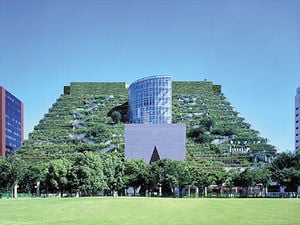
How to be a sustainable city dweller[edit | edit source]
Feeling down about being a city dweller? That somehow you'll never be really green while you're in the city? There's good news: you can be significantly greener in the city - lower carbon output and ecological footprint - than if you lived in the leafy suburbs or on a hobby farm. With intelligent choices, you can be a truly sustainable city dweller.
Daily choices[edit | edit source]
Think first about the biggest impacts, housing and transport. A small but comfortable home, closer to work and to the places you want to go, will not only be greener, but may be a far more enjoyable place to live. Through a modest investment in furniture and storage, willingness to part with items you rarely use, and careful arrangement, small spaces can be made more comfortable than big spaces.
Sustainable living patterns[edit | edit source]
Sustainable consumption[edit | edit source]
We're all consumers, and that's normal. But being conscious of our consumption, choosing less packaging, and choosing to find our identity and our pleasures in relatively sustainable goods, and even more importantly in activities (time in the park, with friends or at a restaurant, rather than the latest consumer goods).
Choosing to holiday at a location reachable by train or bus can be as enjoyable as a long distance plane trip (evidenced by the fact that locals have often never seen the most famous sites in their own states/provinces and nations, while others fly from far and wide to see them.
[edit | edit source]
Cohousing and the Collective House are alternative models of household living - many benefits of community, but with private space and freedom to participate or not. Shared living allows for more efficient use of space and resources.
Food[edit | edit source]
It may be hard to get local food - and there's no guarantee that local food is greener anyway (especially if it's grown in a heated greenhouse). One way to enjoy local, sustainable food is by joining a CSA (Community Supported Agriculture). Another way you can know that your food is sustainable is by growing it yourself.
You live in an apartment? It's still possible, if you have room for a balcony garden and start a worm bin. It may be even better to join or help start a community garden or urban farm. Lobby your local council to allow food gardens on their land.
Other types of garden suitable to cities are vertical gardens, living walls and living roofs (or green roofs).
When you compare the quality of your fresh-picked food with the offerings of the supermarket, you'll be glad.
See also lazy gardening.
Food waste[edit | edit source]
Consider a small indoor worm bin (aka vermicompost or vermiculture) or a composting system. Many cities have programs that provide big discounts on home composters that are built to prevent from rat and other pest infestation.
Water and sanitation[edit | edit source]
Rainwater harvesting and the treatment and reuse of greywater are possible within cities. Even composting toilets, which save large amounts of water as well as using the waste as a rich gardening resource, have been implemented in apartments in Sweden.
City level measures are discussed at #Municipal water and sanitation below.
Energy[edit | edit source]
Use green energy, and use less energy:
- Do a home energy audit and find ways to save. Many cities have local agencies that provide replacement bulbs and other technology to help lower your electrical energy use.
- Look for green power options in your city or town. Do some research (or at least ask if someone else in your area has made a comparison of green energy options), beware of greenwash, and be prepared to pay just a little more. It's still probably much cheaper than installing your own solar panels or mini wind turbine.
The big picture - sustainable cities[edit | edit source]
Many of the biggest factors in making sustainable cities are the choices we make as communities, especially through our governments. Thus being active in our communities, and advocating intelligent green choices in strategic decisions is one of the best things we can do.
The first thing to consider in how sustainable a city can be is its physical layout. Population density and transport planning have a huge impact on sustainability.
See Sustainable cities for more.